Introduction
Best ultra-wide-angle prime: Samyang 14mm f/2.8 IF ED UMC
On full-frame sensors, an ultra-wide-angle lens is defined as having a focal length of 20mm or less, and is an important lens for architecture and landscape photographers. For architecture, and particularly for interiors where space can be restricted, the ultra-wide field-of-view ensures that you can fit everything in. Rectilinear ultra-wide-angle lenses also keep lines straight, so images don’t suffer as much distortion as with fisheye lenses, which is particularly useful for professionals. Ultra-wide-angle lenses can also be used creatively for more dynamic images, as they exaggerate the space between the near and the far. That makes them popular with landscape photographers who want to emphasize something in the foreground to make it look big and dominating. This effect can also work well for a range of other subjects, as well as portraiture or product photography, with unusual and dramatic effects.
We’ve tested four ultra-wide-angle prime lenses on the Canon EOS 5DS R, with scores ranging from a high of 31 points on the Samyang 14mm f/2.8 IF ED UMC Aspherical to a low of 22 points on the Carl Zeiss Distagon T 18mm f/3.5 ZE.
The manual focus $319 Samyang 14mm wins overall with 31 points, offering the best value for money if you can live without autofocus. With 30 points overall, the $2650 Carl Zeiss Distagon T* 15mm f/2.8 costs over 8 times as much, but offers the best lens metrics for sharpness and transmission, as well as for chromatic aberration. At $1999, the Canon 14mm f/2.8L is almost as expensive as the Zeiss, and while comparable for some lens metrics, its sharpness and chromatic aberration are well down compared to the German-made optic.
At the wider aperture settings (f/2.8 and f/4), both the Samyang and Zeiss lenses offer sharper and more homogenous resolution than the Canon 14mm at the same settings. At f/2.8, the Canon 14mm f/2.8L is sharp in the center, but with some edge softness that is improved, but not completely eradicated, by stopping down to f/4. Sharpness is more homogenous on the Canon 14mm between f/5.6 and f/22, with the strongest resolution for the own-brand ultra-wide-angle prime at f/5.6 and f/8. The Zeiss 15mm f/2.8 offers razor-sharp edge-to-edge results between f/2.8 and f/5.6, with resolution at f/8 and f/11 outstanding in the center of the frame, but dropping off a little bit in the outer field. At the minimum f/22 aperture setting on all three lenses, the Samyang actually fares the best for overall sharpness, which is important for landscape photographers looking to extend depth of field.
Best wide-angle prime: Sigma 20mm f/1.4 DG HSM A
We’ve tested 12 wide-angle primes offering focal lengths between 20 and 28mm on the EOS 5DS R, with DxOMark Scores ranging from a high of 40 points on the Sigma 20mm f/1.4 DG HSM A to a low of 23 points on the Canon EF 20mm f/2.8 USM.
The top three podium positions for wide-angle lenses on the EOS 5DS R are occupied by two Sigma options from their Art range of high-quality primes, as well as an own-brand Canon L-series prime. Overall scores for these three optics are very close, with the $1449 Canon EF 24mm f/1.4L II USM achieving 38 points, the $849 Sigma 24mm f/1.4 DG HSM A with 39 points, and the winning $899 Sigma 20mm f1.4 DG HSM A with 40 points. There’s not much between the three lenses for transmission or chromatic aberration, but with a wider 20mm focal length, the winning Sigma 20mm f/1.4 suffers from more distortion at 0.8% compared to 0.3% (Canon) and 0.4% (Sigma) for the 24mm competition.
The Sigma 20mm f/1.4 DG HSM boasts the highest sharpness score of 33 P-Mpix, however, compared to 30 P-Mpix for its 24mm Sigma counterpart, and 27 P-Mpix for the Canon 24mm f/1.4L.
At the maximum f/1.4 aperture, both Sigma wide-angle primes offer better outer field resolution compared to the Canon 24mm f/1.4 and are slightly sharper in the center, too. Although at the minimum aperture the Sigma lenses also offer greater resolution, the Canon closes down an extra stop to f/22, compared to f/16 on the Sigma Art lenses, which could be important for photographers after greater depth of field. The Sigma 20mm f/1.4 A offers its best sharpness between f/4 to f/11, where resolution is both strong and homogenous. At the wider f/1.8 and f/2.8 apertures, sharpness at the center is also strong, with just a little drop-off at the edges.
It’s a similar story for the Sigma 24mm, although the longer focal length lens is more homogenous at f/2.8 compared to its 20mm counterpart, and so offers excellent sharpness between f/2.8 to f/11. Although the Canon 24mm posts the weakest overall sharpness score, bear in mind that this score is affected by results at f/22, which is an aperture setting the Sigma lenses don’t offer. That said, although the Canon is very good in the center of the frame between f/2.8 to f/8, there’s a small amount of edge softness even at these settings. This means the Canon 24mm f/1.4 is only truly homogenous at f/11, but even at this setting, it’s still just a little softer than the Sigma competition.
Best wide-angle zoom: Sigma 24-35mm f/2 DG HSM A
We tested a total of eleven wide-angle zoom lenses covering focal lengths between 11mm to 35mm on the EOS 5DS R, with DxOMark scores ranging from a high of 36 points on the Sigma 24-35mm f/2 DG HSM A (another Sigma Art lens) to a low of 17 points on the Sigma 12-24mm f/4-5.6 EX DG.
The top three podium position lenses are all slightly different propositions, offering varying focal lengths and maximum apertures. With 36 points, the $999 Sigma 24-35mm f/2 offers the widest maximum aperture, as well as sharpness scores comparable to the wide-angle primes we’ve just looked at, but has a fairly limited focal range.
The $3000 Canon EF 11-24mm f/4L (in second place with 28 points) is by far the most expensive, but offers the greatest focal range and is the widest rectilinear zoom lens currently available for full-frame. In terms of focal length, the Tokina 16-28mm f/2.8 is a good compromise between the Sigma and Canon competition, and at $589 offers good value for money, too.
With the highest sharpness score of 32 P-Mpix, the Sigma 24-35mm f/2 offers good resolution at all aperture settings at both ends of its zoom range. It’s best at 24mm, where it’s strong and homogenous at all aperture settings, but its greatest resolution is between f/4 and f/8 at 24mm. At the minimum aperture setting, the Sigma 24-35mm is also the strongest of the three podium-position lenses, but offers only a minimum f/16 aperture compared to f/22 on the Canon and Tokina alternatives.
At the widest 11mm focal length, the Canon 11-14mm f/4L boasts excellent edge-to-edge resolution between f/4 to f/8. At f/11, a little edge softness starts creeping in, and although sharpness is homogenous at 11mm and f/22, it’s softer overall. At the other end of the focal range, the Canon 11-24mm f/4L isn’t quite as good overall at 24mm, with strong center resolution at apertures f/4 to f/11, but greater drop-off in the corners at these settings compared to results at 11mm.
At its widest 16mm focal length, the Tokina 16-28mm has the best sharpness between f/4 to f/8, while at 24mm, its strongest resolution is recorded between f/5.6 and f/11. At the maximum f/2.8 aperture, edge softness occurs at all focal lengths, with the best center resolution between 24mm to 28m. At f/22, the Tokina is homogenous at all focal lengths, but again slightly softer overall (as you’d expect due to the impact of diffraction at this minimum aperture setting).
Best telephoto macro: Carl Zeiss Makro-Planar T 100mm f/2 ZE
Macro lenses offer close-focus capabilities with a magnification factor of 1.0x or 1:1 at the minimum focus distance, for life-size reproduction of tiny subjects such as insects. These lenses don’t have to be used at the minimum focus distance, however, and featuring focal lengths between 90 and 180mm along with large maximum apertures, they also double as a good portrait or product photography lens on the EOS 5DS R. We’ve tested nine macro lenses on the EOS 5DS R, with DxOMark scores ranging from a high of 38 points on the Carl Zeiss Makro-Planar T 100mm f/2 ZE to a low of 23 points on the Tamron SP AF180mm f/3.5 Di LD (IF).
With 38 points overall, the Zeiss 100mm f/2 macro lens offers the best lens metric results in almost all categories, including sharpness, transmission, distortion, and CA. Although now discontinued and replaced with the $1843 Zeiss Milvus 100mm f/2 alternative, the older lens is still available on the second-hand market for around $1250.
In joint 2nd place with 34 points, the $799 Canon 100mm f/2.8L and $499 Tamron SP AF 90mm f/2.8 Di offer good-quality cheaper macro alternatives on the EOS 5DS R, but with smaller f/2.8 maximum apertures. The larger f/2 maximum aperture ensures greater light transmission with the Zeiss, too, achieving a score of 2.3TStop — a full stop better than the 3.3Tstop scores for the Canon and Tamron alternatives. The Tamron lens manages to take the plaudits for vignetting, however, offering a 0.5-stop advantage at 1.0Ev compared to 1.5Ev for both the Zeiss and Canon 100mm macro-lenses.
In the crucial lens metric of sharpness, however, the Zeiss 100mm f/2 is head and shoulders above its rivals, achieving a score of 30 P-Mpix compared to 24 and 23 for the Canon and Tamron, respectively. All three optics offer homogenous results at all aperture settings, which is obviously a bonus if you’re intending to fill the frame with some fine details, such as an insect or flower. Offering good resolution at f/2, the Zeiss is tack-sharp between f/2.8 and f/11, but a little bit softer overall at its minimum f/22 aperture setting. Although not quite as sharp at their best settings, both the Canon 100mm f/2.8L and Tamron SP 90mm f/2.8 still offer great sharpness between f/2.8 and f/11. Although both are a little softer at f/32, they’re still very good and actually slightly better than the Zeiss at f/22, which is important when capturing macro shots at the minimum aperture setting.


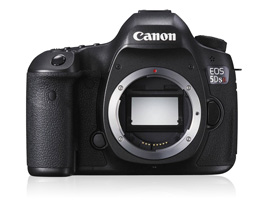

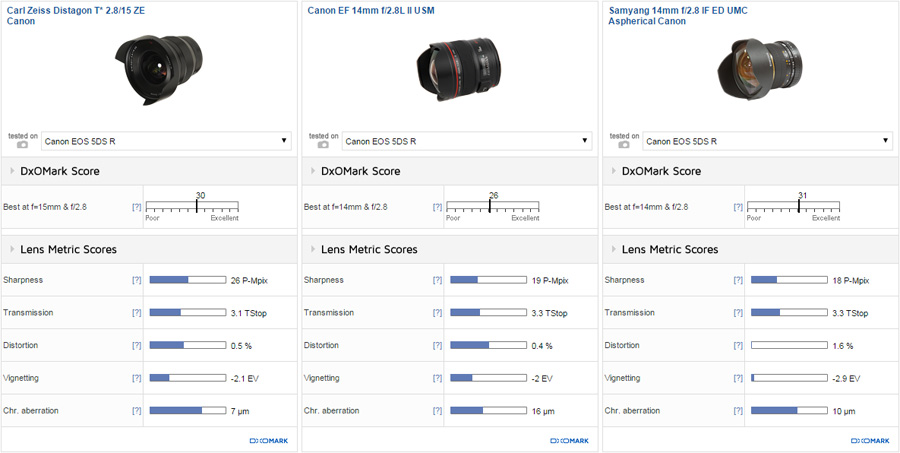
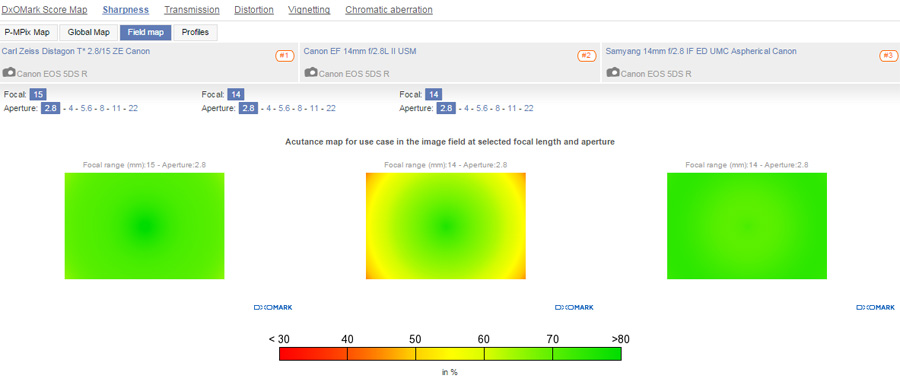
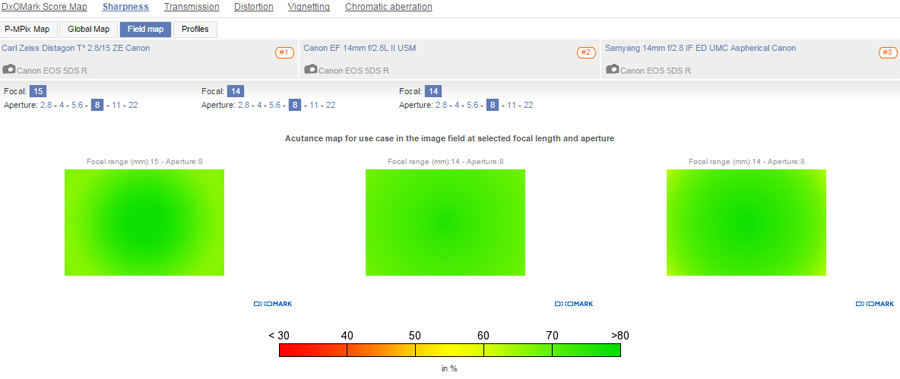
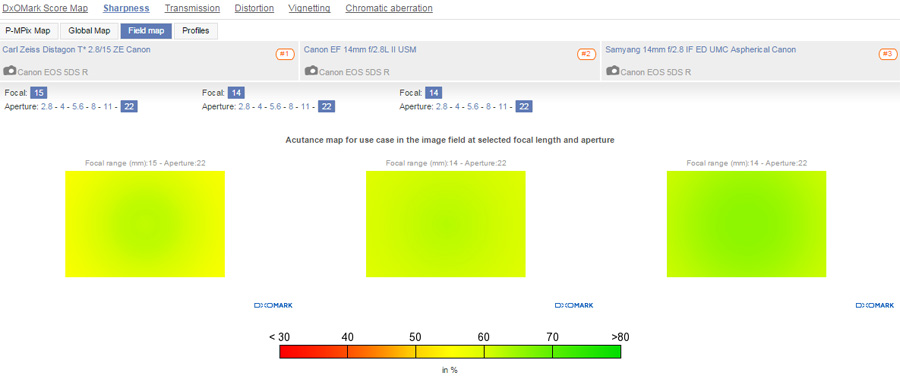
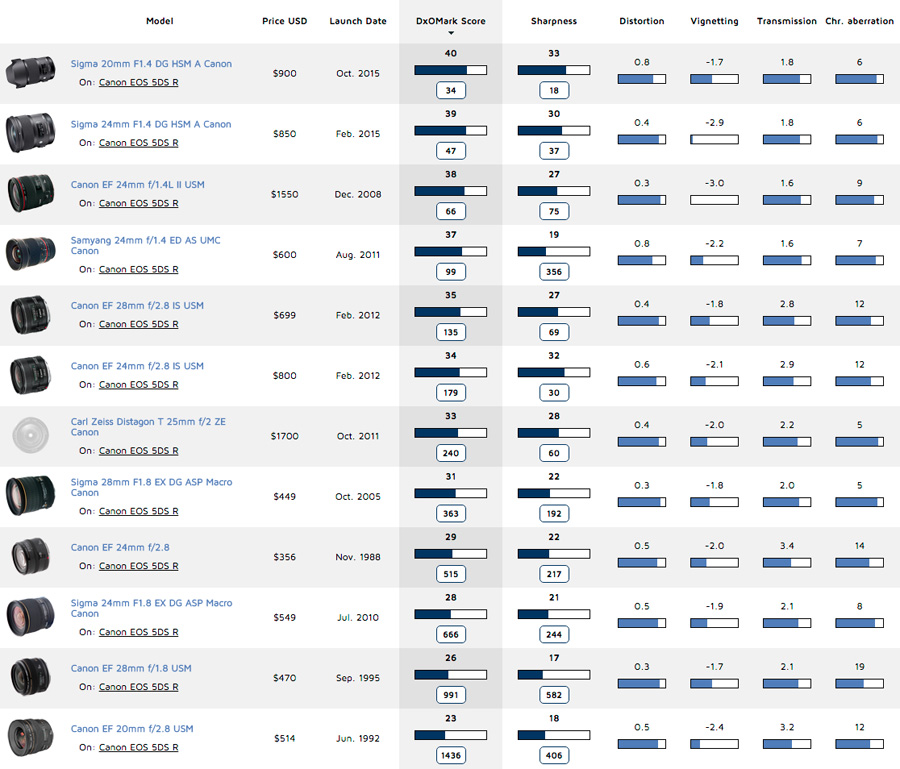
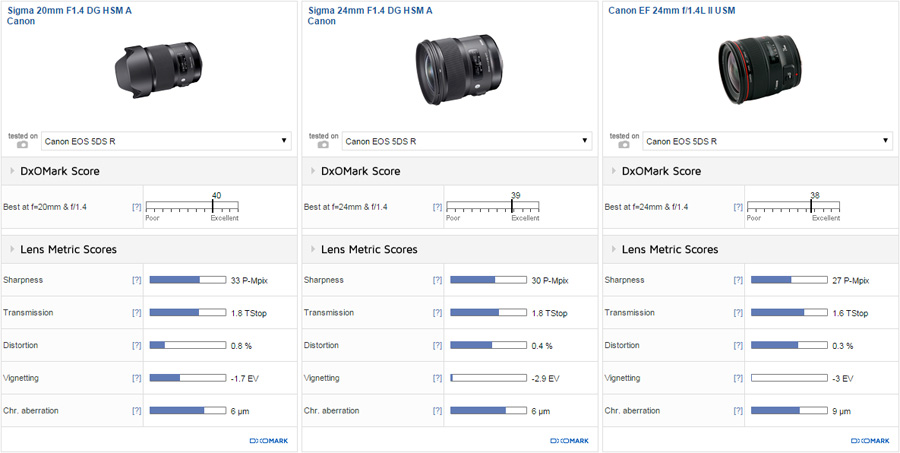
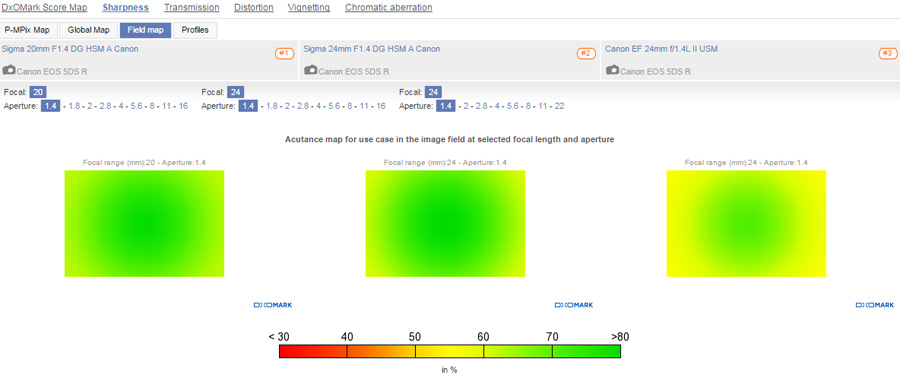
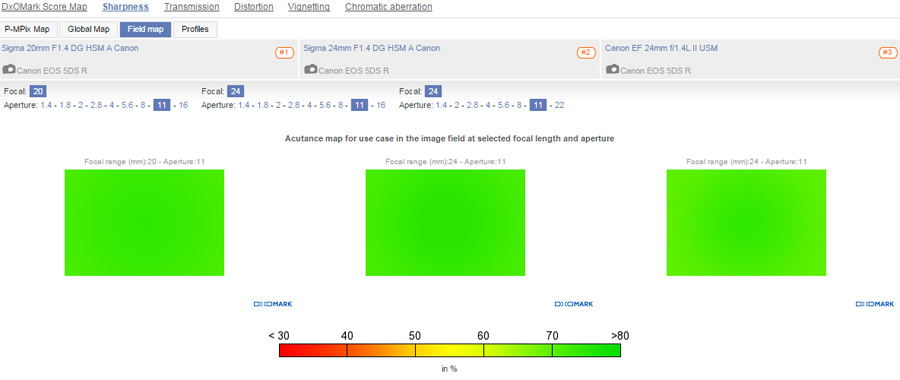
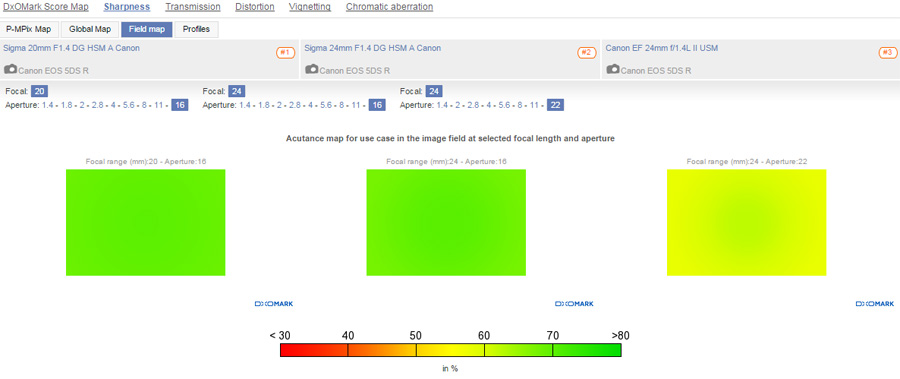
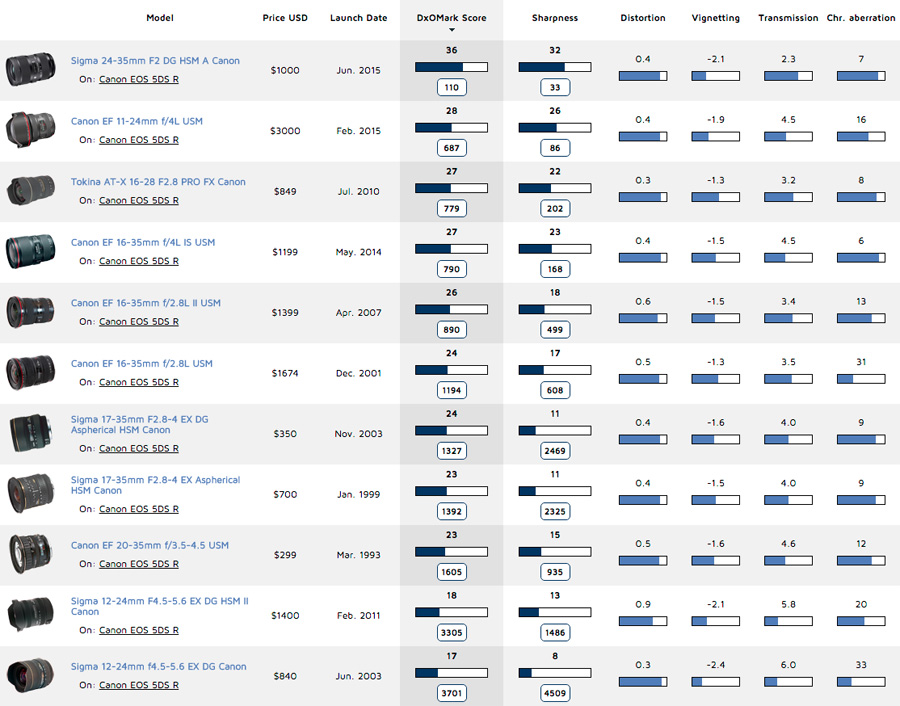
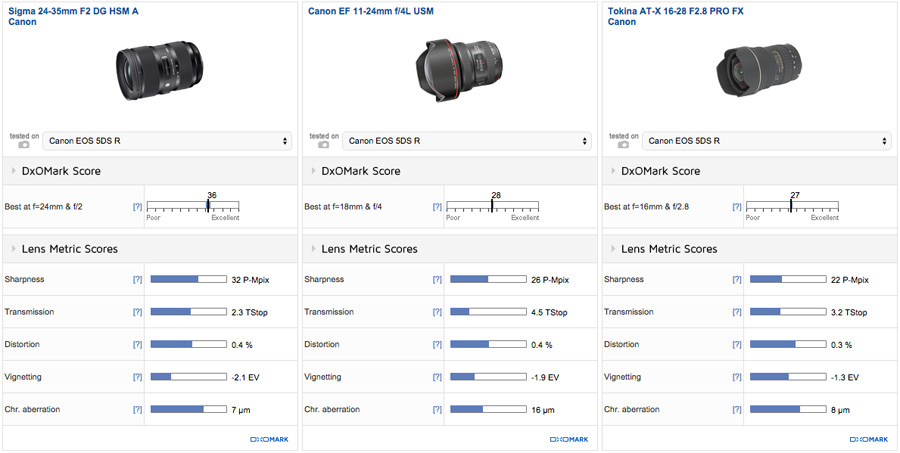
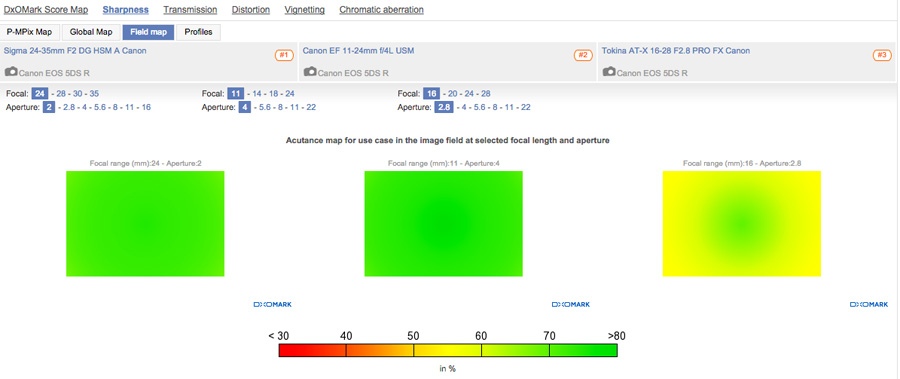
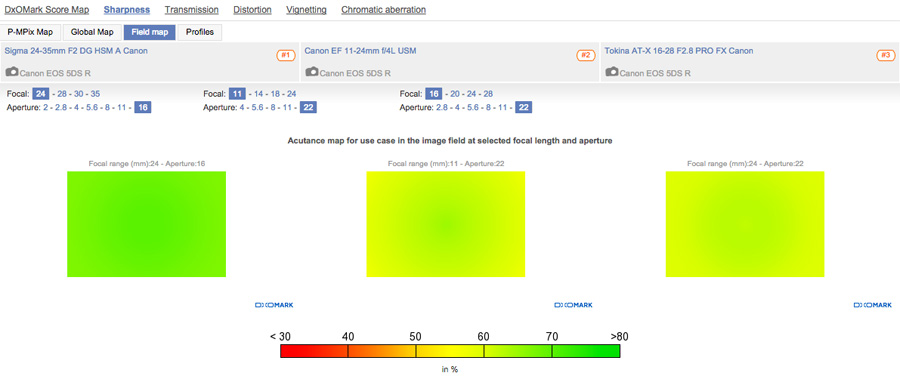
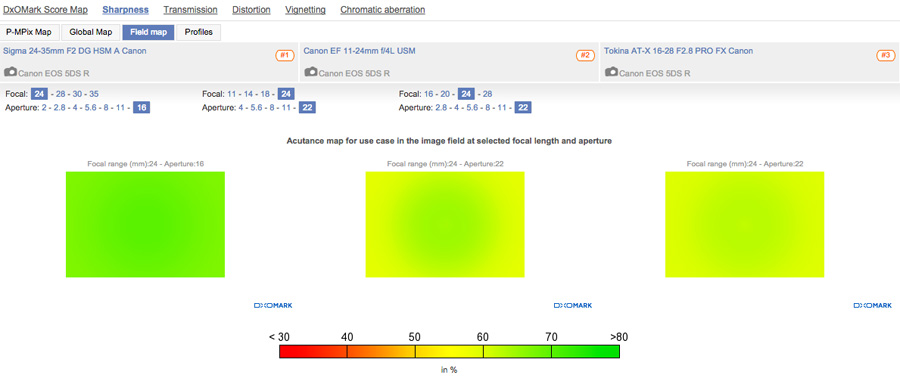

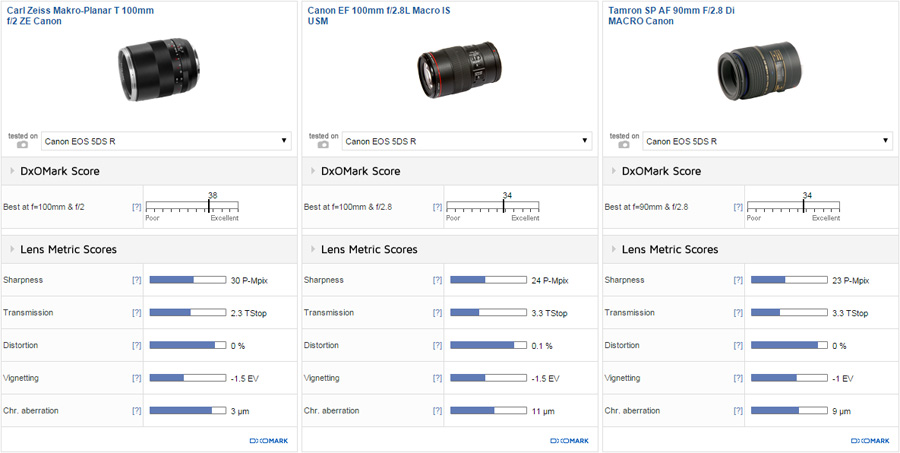
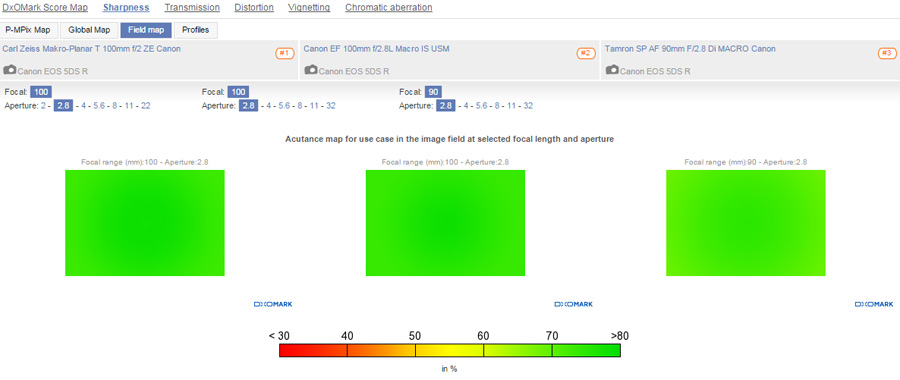
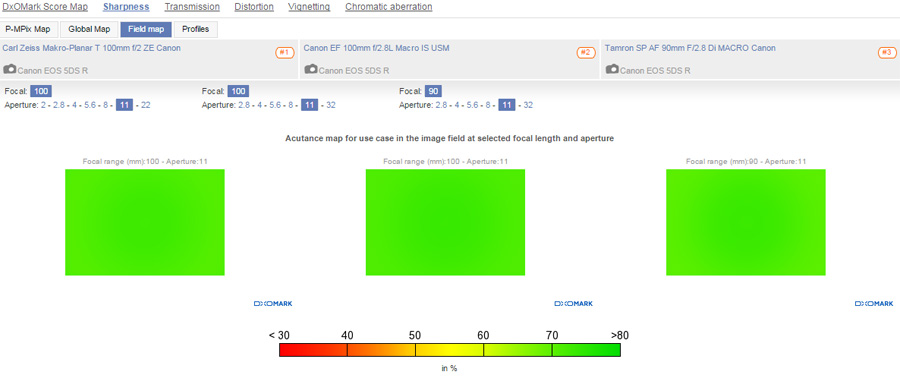
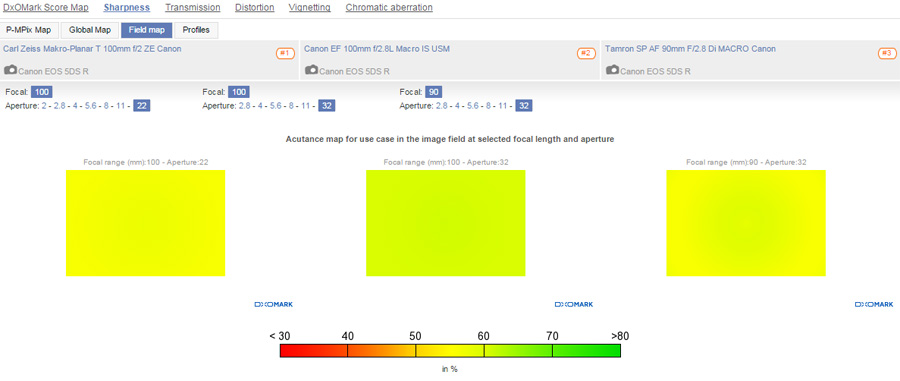
DXOMARK encourages its readers to share comments on the articles. To read or post comments, Disqus cookies are required. Change your Cookies Preferences and read more about our Comment Policy.